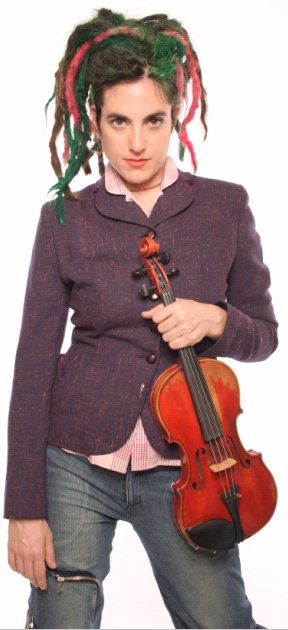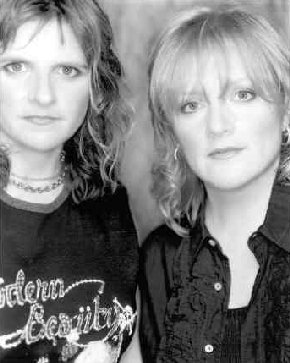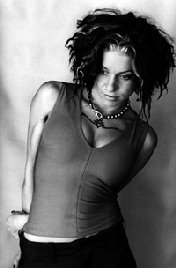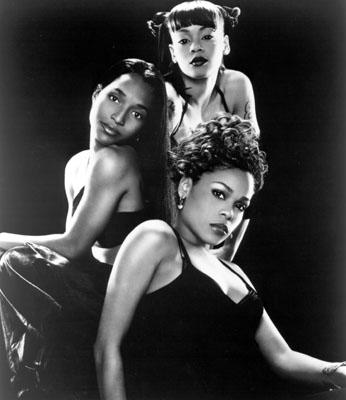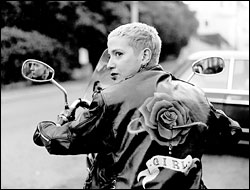 |
||||||
|
The History of Riot Grrls
The History of Riot Grrls in Music
By Kristen Schilt. "Because I believe with my wholeheartmindbody that girls constitute a revolutionary soul force that can, and will, change the world for real" - Riot Grrrl Is 44. "Girl power!" - Spice Girls.
IntroductionFemale rock musicians have had difficulty making it in the predominantly white male rock world. Joanne Gottlieb and Gayle Wald note that women's participation in rock music usually consists of bolstering male performance, in the roles of groupie, girlfriend, or back-up singer (257). Even in punk rock, women are often treated as a novelty by the music press and cultural critics. Male bands such as the Sex Pistols and the Damned achieve rock notoriety while their female counterparts, like the Slits and the Raincoats, sink into obscurity. However, 1995 saw an explosion in the music press about a new group of female musicians: the angry women. Hailed in popular magazines for blending feminism and rock music, Alanis Morissette topped the charts in 1995. Affectionately named the "screech queen" by Newsweek, Morissette combined angry, sexually graphic lyrics with catchy pop music (Chang 79). She was quickly followed by Tracy Bonham, Meredith Brooks, and Fiona Apple. Though they differed in musical style, this group of musicians embodied what it meant to be a woman expressing anger through rock music, according to the music press. Popular music magazines argued that musicians like Morissette were creating a whole new genre for female performers, one that allowed them to assert their ideas about feminism and sexuality. However, looking back to 1991, the "angry women in rock" phenomenon appears to be only a commercial version of an earlier group of female musicians associated with Riot Grrrl. In this study, I compare the treatment of Riot Grrrl-associated bands in the popular and musical press and the treatment of the "angry women in rock." I examine articles about Riot Grrrl and Riot Grrrl-associated bands from 1991 to 1993 that appeared in popular news and music magazines (see Appendix for a complete list). I then examine articles in the same magazines about "angry women in rock," including Alanis Morissette, Fiona Apple, Tracy Bonham, Meredith Brooks, and the Spice Girls. After outlining how the articles differ in their representations of these two groups, I illustrate how the angry women in rock appropriated key concepts from the Riot Grrrl movement and turned them into a million-dollar enterprise.
The Emergence of the Riot GrrrlsRiot Grrrl began in 1991, when a group of women from Washington, D.C., and Olympia, Washington, held a meeting to discuss how to address sexism in the punk scene. Inspired by recent antiracist riots in D.C., the women decided they wanted to start a "girl riot" against a society they felt offered no validation of women's experiences. The name "Riot Grrrl" emerged. The use of the word "girl" came from a desire to focus on childhood, a time when girls have the strongest self-esteem and belief in themselves (White 397). The rewriting of the word as "grrrl" represented the anger behind the movement; it sounded like a growl (Carlip 9). Because the founding women had ties to punk, a genre known for using performance and shock value as tools of protest, Riot Grrrl had a more radical orientation than other feminist organizations such as the National Organization for Women. As Emily White commented in Rock She Wrote: Women Write About Rock, Pop and Rap, "Riot Grrrl co-opted the values and rhetoric of punk, fifteen years after the fact, in the name of feminism--or as they call it 'revolution-girl style now'" (397). At its inception, Riot Grrrl issued a manifesto stating its philosophy and intent. The manifesto was published in various Riot Grrrl "zines", such as Riot Grrrl and Bikini Kill. Zines (short for "fanzines") are homemade publications with limited distribution. Zines became an important part of the punk scene in the late 1970s because punks liked "producing a paper unhampered by corporate structure, cash and censorship" (Burchill and Parsons 37). Zine making was a predominantly male domain, however. Mark Perry, one of the early punk zine makers, wrote in one issue of Sniffin' Glue: "Punks are not girls, and if it comes to the crunch we'll have no options but to fight back" (Reynolds and Press 323). In the hands of the Riot Grrrls, however, zines became a medium for discussing taboo subjects, such as rape, incest, and eating disorders. Zine making offered girls a way of forming connections with other girls who shared their experiences. The formation of these connections allowed girls to see their own personal experiences with rape and assault as part of a larger political problem. As Hillary Carlip wrote in Girlpower, "In zines, [Riot Grrrls] are finally free to express themselves fully, to be heard, and also to realize they are not alone" (34). Zine making offered many girls a forum in which to discuss the marginalization they felt in the predominantly male punk scene and to discuss sexism and harassment with other girls and women who shared similar experiences. Bikini Kill was one of the earliest Riot Grrrl-associated zines. The first issue, which came out in 1991, was primarily written by Kathleen Hanna and Tobi Vail, members of the band Bikini Kill. Issue 2 contained a version of the Riot Grrrl manifesto, which listed many reasons why Riot Grrrl was necessary: Riot Grrrl is:
BECAUSE we know that life is much more than physical survival and
are patently aware that the punk rock 'you can do anything' idea
is crucial to the coming angry grrrl rock revolution which seeks
to save the psychic and cultural lives of girls and women
everywhere, according to their own terms, not ours.
("Riot Grrrl Is" 44)
The zine also included an article on fat oppression and a list of the top ten sexist responses to feminist beliefs and suggestions on how to rebut them. Tobi Vail also produced a zine entitled Jigsaw. The jigsaw puzzle was a metaphor frequently used by Bikini Kill to describe the confusion of girls who were trying to see where they fit into a male-dominated world. In the liner notes of the Bikini Kill self-titled 1994 CD, Kathleen Hanna writes, "Don't freak out cuz [sic] the jigsaw is laying on the floor and it's not all the way done and has been there for 4 whole hours now, resist the freak out. You will get it ... it's all part of the process." In addition to circulating information about feminism, zines were also used as a forum to confront racism in the punk scene. Allison Wolfe, the singer for Bratmobile, edited a zine called Girl Germs. Wolfe criticized the white privilege in the punk (and Riot Grrrl) scene and tried to get others to recognize and confront it in themselves. Other zines, such as Gunk, offered more in-depth critiques of the predominantly white scene and what could be done about it. Gunk's editor, Dasha, writes, "I used to laugh at this whole white bread punk scene, but now I'm not laughing as much as I'm getting annoyed" ("I'm Laughing" 3). She also discusses the implications of punks who claim the status of "white niggers" and what the term means to an African-American punk like herself. Reading other girl-zines enabled girls to see their experiences of racism, abuse, and harassment as political issues rather than isolated personal incidents. As the word spread about these homemade magazines that told unbowlderized versions of adolescent girls' lives, more and more girls attempted to reach out to other girls through the girl-zine network. When Sassy, a popular teen magazine from the early nineties, published the addresses of several Riot Grrrl zines, many of them were forced to stop production because they couldn't handle the flood of mail they received. Many of the Riot Grrrl zine makers felt that this was a testament to how zines validated girls' experiences and made them feel that they were not alone.
Forming connections through musicSimilar to girl-zines, the bands associated with Riot Grrrl used their music to express feminist and antiracist viewpoints. Bikini Kill, Bratmobile, and Heavens to Betsy (all Riot Grrrl-associated bands) created songs with extremely personal lyrics that dealt with topics such as rape, incest, and eating disorders. Again, girls who heard these songs had the experience of realizing how their own personal problems fit into larger political structures. Members of Riot Grrrl-associated bands also received scores of letters from girls who wanted to relate how these lyrics had affected their lives. When I interviewed Kathleen Hanna in 1998, she said,
I still have been getting as many letters as I did in the first two months of Riot Grrrl. I still get as many letters about feminism, about all kinds of things--girls with eating disorders, girls who are being sexually assaulted in their homes--see I get the same kind of mail. The same amazing mail. That the volume of mail had not decreased in eight years underscores the ability of bands like Bikini Kill to address issues that speak to many girls' lives. In the Bikini Kill song "Feels Blind," Kathleen Hanna addresses how society teaches women to hate themselves. The words, "As a woman I was taught to always be hungry/yeah women are well acquainted with thirst/we could eat just about anything/we could even eat your hate up like love," show how self hatred can emerge in the form of an eating disorder, or in the tolerance of an abusive relationship. Another song, "Don't Need You," proclaims "don't need you to say we're cute/don't need you to say we're alright/don't need your protection/don't need your kiss goodnight," rejecting stereotypical heterosexual relationship dynamics. In her pre-Bikini Kill bands, Hanna is equally uncompromising in her lyrical subjects. On "Kalvinator," from her 1990 band, Viva Knieval, Hanna sings, "If I were a boy I might be small time powerful like you/and I might even fuck a girl who's like me," ridiculing the sexist attitudes of male musicians in the punk scene. She follows the same theme in the Wondertwins song, "If I Were a Real Woman," describing a "real woman" as a "sunburnt baby waiting for you." These lyrics offer a critique of the social construction of the "perfect" woman. Bratmobile, another Riot Grrrl-associated band, also explores socially constructed stereotypes of women. In the song "Teenager," Allison Wolfe sings, "I'm not jaded to the bone/I'm not little Miss Knowledge/I'm not hooked up to the phone/I'm not just a piece of college/I'm a teenager," illustrating how girls don't fit into perfect, rigid classifications. The members of Bratmobile also write songs that show the spunky "grrrl" side of women. In the song "Girl Germs," Wolfe sings about playground friendships and how boys need to confront their "boyish fears of girl intimidation." In a more serious vein, the band also deals with critiques leveled at Riot Grrrl for being so white and middle class. In the song "Polaroid Baby," Wolfe sings "We're so white and we're so cute," suggesting that many white people equate whiteness with desirability. Wolfe points out the inherent advantages of being white and suggests that people need to address that advantage and do what they can to minimize it. Heavens to Betsy also examines the predominantly white punk movement. In the song "White Girl," Corin Tucker says, "white girl/I wanna change the world/but I can't change anything/until I change my racist self." Both Bratmobile and Heavens to Betsy cast a critical eye on the predominantly white punk scene and call for more examination of whiteness and privilege.
The Press Vs. Riot GrrrlProponents of Riot Grrrl wanted to reach out to as many girls as possible, but were reluctant to use mainstream media for that purpose. The performance style of many of the bands shocked some journalists, leading to negative and condescending articles about Riot Grrrl. Kim France writes of Riot Grrrl in 1993, "They do things like scrawl SLUT and RAPE across their torsos before gigs, produce fanzines with names like Girl Germs and hate the media's guts. They're called Riot Grrrls, and they've come for your daughters" ("Grrrls" 23). In interviews I have conducted with founders of Riot Grrrl, they maintain that writing "SLUT" and "RAPE" on arms and stomachs was intended to draw attention to constraints placed on women's sexuality and to publicize issues such as sexual abuse and rape that were largely ignored by the media. Riot Grrrl emphasized the importance of placing taboo subjects such as sexual abuse out in the open. At Bikini Kill shows, microphones were often passed around so that the audience could share stories of sexual abuse. But while most reports about Riot Grrrl mentioned the body writing, no reporters delved into why Bikini Kill employed these tactics, or connected it to the serious issues of incest in middle-class white America. Stories about Riot Grrrl often were misinformed, antagonistic, or banal. In the liner notes to Bikini Kill's self-titled 1994 CD, Tobi Vail outlines why the group refused to do interviews: too often the band had been misrepresented and taken out of context, making them appear immature and ridiculous. In Angry Women in Rock, Andrea Juno quotes Kathleen Hanna as saying that Newsweek purchased a picture of her and friends at the beach in bikinis to print with the article about Riot Grrrl (85). The photo was purchased in an effort to discredit her feminism; she was in a band called Bikini Kill yet she wore bikinis. Hanna tells Juno that The Washington Post ran a story on Bikini Kill (without interviewing the band) and incorrectly reported that Hanna claimed her father had raped her. Hanna had many relatives in D.C. and the article caused her a lot of embarrassment and hurt her family. Other reports were simply condescending. A reporter from The Evening Standard wrote of Riot Grrrl, "Their ideas may be babyish. But at least they have some" (Leonard 243). Melody Maker, the leading music journal in England, writes, "The best thing that any Riot Grrrl could do is to go away and do some reading, and I don't mean a grubby little fanzine" (Leonard 243). The authors of these articles gave Riot Grrrl a cursory glance and dismissed the movement as juvenile and unimportant. Zine editors tried to rise to the challenge of defending Riot Grrrl. Bethany, writing in Gunk, says, "Bikini Kill is now an alternative image of women. The media only gets one image, it can be distorted. They don't know Kathy, Tobi, Billy or Kathleen" ("Beth's Letter" 11). Sasha, the editor of Cupsize writes, "Most people took their SPIN soundbite accounts of Riot Grrrl and ran with them, feeling free to apply the label to any feminist or female rocker" ("Riot Grrrl" 28). In a reaction to the negative press, women who identified as Riot Grrrls initiated a media blackout. However, this anti-media stance only increased the number of negative, uninformed stories about Riot Grrrl. Gottlieb and Wald conclude their article on Riot Grrrl saying, that if Riot Grrrl truly wanted to offer its form of feminism to the masses, they needed to abandon their belief in the power of the subculture and start working with the media (271). This statement, however, misses the point of Riot Grrrl. As Marion Leonard notes, "The goal of many of those involved [in Riot Grrrl] was not to gain mass attention but to encourage girls and women to communicate with each other" (247). Some members of Riot Grrrl remained steadfast in their rejection of the media and others remained open to the media. Whatever the stance of individual Riot Grrrls, however, the media soon lost interest and stories about the death of Riot Grrrl began to appear in 1995 and 1996.
|
|
|||||
|
|
||||||
|
Enter the angry womenAfter the supposed death of Riot Grrrl, the popular press soon found a new focus. In 1995, Alanis Morissette burst onto the music scene. Morissette's first hit single, "You Oughta Know," quickly gained mass attention. The song's lyrics described a love affair gone awry in angry, graphic terms. Morissette tells her ex-lover that she's "not gonna fade away" and outlines her revenge for being left for an older woman. Lyrical anger, which had hitherto been male territory (Gottlieb and Wald 254), had a very female voice in Morissette's lyrics. Her album, Jagged Little Pill, sold 48,000 copies in 1995 alone, which is astonishing for an unknown performer (Borzillo 1). At 21 years of age, Morissette was suddenly being hailed as a new feminist heroine. Morissette's success paved the way for other "angry" women: Tracy Bonham, Meredith Brooks, and Fiona Apple. Tracy Bonham gained notoriety in 1996 for her song "Mother Mother." The song, which begins as a poppy, lighthearted tune, ends with the howling rage of a twenty-something whose life isn't working out as planned. Meredith Brooks appeared next with her song "Bitch," which Newsweek called "a post-feminist celebration of moodiness" (Chang 79). With lyrics like "I'm a bitch/I'm a tease/I'm a goddess on my knees," Brooks told Newsweek she wanted to erase the negative meanings of words like "bitch" by "owning them" (Chang 79). While Newsweek seemed reluctant to believe her intent would be successful, they did give the song, and the album, Blurring the Edges, rave reviews. Fiona Apple was the next to become an overnight success. Her album, Tidal, came out in 1996. And then came the Spice Girls, another female sensation. Though they were not angry like Morissette, they brought a feminist aspect to their performance by chanting "girl power" at their concerts. These women opened a new page for women in rock. They were strong, they sang about sex, and they didn't shy away from addressing their issues with men. However, while they were frequently grouped together under the title of "angry women in rock," they were all very different both in musical style and lyrical subjects. Morissette, the first in the new angry-women-of-rock phenomenon, was the most loved by the media. The New York Times hailed her as a heroine for young girls (Pareles C11) and the voice for her generation (Borzillo 1). Unlike the Riot Grrrls, she formed a friendly tie to the media, which allowed her to be angry but still well reviewed. Fiona Apple covered issues similar to Morissette on her album but differed stylistically. Unlike Morissette, who plays no instrument, Apple plays the piano to accompany her work. Her vocal style was also more sedate, leading Time to label her a "muted Alanis Morissette" (Farley 79). Tracy Bonham and Meredith Brooks, who both play guitar on their albums, were also compared to Morissette in reviews. Brooks, whose style is more folky than pop, balked at this comparison. She claimed she was not "angry" and that her album was about "resurrection." Despite their protests, however, they were still grouped together by rock journalists.
Examining the success of the angry womenMany of the "angry women's" issues were similar to those of the Riot Grrrl bands who came before them, such as reclaiming misogynist terms or addressing sexual abuse in their lyrics. Yet the new feminist "heroines" were far more successful. Their albums were well reviewed and their singles stayed at the top of the charts. One reason behind the positive reception can be found in their presentation. Gottlieb and Wald note that many Riot Grrrl bands avoided major record labels because these contracts could potentially threaten the integrity of the bands by forcing them to "tone down" their music and change their image to include new clothing and hairstyles (251). Fiona Apple, in an interview with Rolling Stone, acknowledges that she has a very carefully constructed image. She told reporter Chris Heath that her goal is to "start out being lean and the absolute perfect marketing package," then gain enough fame to be able to look however she wants (68). Bands that were associated with Riot Grrrl started their musical careers with total control over their image because they were on independent record labels. By not conforming to traditional beauty standards, Riot Grrrl-associated bands appeared too threatening to major labels. Morissette, and the other performers who were grouped with her, were all on major labels from the start. Their music was of the produced, packaged, pop variety that has historically done well on the radio, not the angry punk style of Riot Grrrl-associated bands. Sara Cohen, in her article, "Men Making a Scene: Rock Music and the Production of Gender," notes that women are often associated with pop music and mass commercial entertainment while men are associated with rock and authenticity. This idea suggests a possible source of Morissette and Apple's great popularity: although they were angry, they still were operating within the realm of pop music. Riot Grrrl-associated bands, however, crossed over to the punkier, rock side of music, challenging the typical male form of expression. Norma Coates writes:
Women who play rock which follows all of the rules of 'authenticity'--lack of artifice, standard even stripped-down instrumentation and frank, often sexually explicit lyrics--throw the category of 'rock' in flux by transgressing and threatening to expose the artificial gender boundaries erected by the technologised machinations of power. (53) While Riot Grrrl-associated bands offered such a challenge, the new angry women did not. The only difference between Mariah Carey and these new stars was that their lyrics addressed sex and other taboo subjects. They had inherited the legacy of Riot Grrrl and "improved" upon it by setting shocking lyrics to familiar pop music. Dick Hebdige notes that in order to render a subculture non-threatening, it must be pulled into the mainstream and commodified. Looking at the "angry women in rock" phenomenon, it is clearly an example of the incorporation of a radical movement. Morissette and Apple focused their anger on many of the same issues as Riot Grrrl; however, they were carefully constructed as non-threatening and their form of female empowerment was something to buy in CD format rather than something to actively produce. In interviews, they were well behaved and polite. And, unlike Kathleen Hanna, they did not talk about feminism or the oppression of women. They simply followed the traditional interview procedure of answering questions. This, coupled with their pop music style and stereotypically feminine appearance, allowed them to be angry without being threatening.
Listening to the angry women: a lyrical analysis.A close study of interviews with Fiona Apple shows how journalists took the radical lyrics of the "angry women in rock" and rendered them non-threatening. Apple is the performer with the most in common with the Riot Grrrl-associated bands of the early 1990s. When her album Tidal debuted, Apple was nineteen years old, the youngest of the "angry women" group. Like Bikini Kill, she has songs that address her own experiences of rape and eating disorders. She drew public attention with her song "Sullen Girl," in which she relates her story of being raped at the age of twelve. Many of her interviewers focus on her personal rape story, as was also the case for Bikini Kill. In the liner notes to their 1994 CD, Bikini Kill, Tobi Vail writes that the music press tried to focus on their own personal abuse stories and not on how they were trying to use them to reach out and empower women with the same experiences. Similarly, in an interview with Rolling Stone, Apple tells Chris Heath that she talks about her rape experience because she doesn't think it is something that she should be embarrassed about (68). Heath contends that if Apple "shares her problems, it is to normalize them, not to offer them up as public melodrama" (68). However, other interviews suggest otherwise. In an interview with the New York Times, Apple notes that she is tired of talking about her experience and doesn't "want to be like the rape poster girl" (Erlich H34). Another article for the New York Times discusses her performance of the song "Sullen Girl":
As inspiring as it was to see a precocious teen-age girl becoming sure of herself, the spectacle could not fully sustain itself as art. By making her private journey public, Ms. Apple embodies our confessional age; now it's up to her to take the next step in realizing her own considerable potential. (Powers B7) Powers lauds Apple's self-assurance, saying that she "exemplifies the vitality of today's young women, perhaps the first generation to begin with a sense of themselves as a force to be reckoned with" (B7). While this seems like high praise, it is also merely repetition of what was said about Riot Grrrl. In a 1992 article about Riot Grrrl, which appeared in Newsweek, Farai Chideya wrote, "They may be the first generation of feminists to identify their anger so early and to use it" (84). Despite the celebration of Apple's self-assurance, the author still insinuates that Apple's confessional songwriting is merely indicative of her lack of maturity, rather than a political statement condemning the lack of rape awareness. Another issue that links Morissette and Apple to Riot Grrrls is their lyrical discussion of the stigma attached to female sexuality. In the song "Criminal," Apple says she feels "like a criminal" because of being a woman with sexual desires. The video shows an almost naked Apple writhing around on the ground. Because she uses the typical music video convention of displaying the naked female body to attract viewers, it is debatable how much of the positive message about female sexual desire gets through. Alanis Morissette also discusses sex in a frank voice. While "You Oughta Know" had to be edited for radio play because of the sexually explicit lyrics, the song still includes a line where Morissette asks her former lover if the one he left her for would "go down on you in a theater." Her revenge to her lover for leaving her for an older woman is also described, "'cause the joke that you laid in the bed was me/and I'm not gonna fade as soon as you close your eyes and you know it/and everytime I scratch my nails down someone else's back/I hope you feel it." It is unusual to hear women describing sex in such graphic terms on the radio. Even the Spice Girls have something to say about sex. Their song, "Wannabe," details the rules for prospective lovers. One rule, "If you want my future/forget my past," shows women could have sexual histories, like men, and not be ashamed of it. Though these lyrics aren't as explicit as, say, "I Like Fucking" by Bikini Kill, it is a big step for American women, who rarely hear female desire being expressed on the radio. Or is it? While sex is being addressed, nothing revolutionary is being said. Fiona Apple may feel like a criminal for her desires, but she still catches the public's eye with her body, not her message. Apple tells Rolling Stone there is an advantage to being a woman in rock because "you always have your sexuality to lure people with" (McDonnell 124). Though she adds that it can also be a disadvantage because people sometimes can't see past your sexuality, she still supports the stereotype that women are recognized first for their sexuality and then for their musical abilities. As I mentioned before, Apple is one of the few mainstream performers to deal with issues such as rape, eating disorders, and self-mutilation. Yet, she fails to make the societal connection that was so important in Riot Grrrl when she discusses her own experiences with these issues. Unlike Kathleen Hanna or Tobi Vail, who take society to task for problems such as rape and incest, Apple places the blame all on herself. Therefore, Apple's discussion of taboo topics is not threatening because she suggests that she is at fault. Reading interviews with Apple, it is debatable whether the reporters are even listening to her discussion of sexual abuse and eating disorders. The New York Times titled an article about Apple "A Message Far Less Pretty than the Face" (Ehrlich H34), which suggests that her personal beauty is more newsworthy than anything she might have to say. The article begins, "The pouty bee-stung lips. The taut, pierced belly exposed by a flouncy shirt. The cascading honey-brown hair. And those eyes. Is this the next waif supermodel?" (Erhlich H34). Very little is mentioned about her piano playing, illustrating a point Simon Frith makes about women performers. Frith argues that when women are the focal point of a performance, their musical abilities are often "confused with their visual images and style" (85). This appears to be what is happening to Fiona Apple. Because her anger is internalized, she is rendered non-threatening, allowing reports to focus on her personal beauty and not her thoughts. In the case of Morissette's "You Oughta Know," the lyrics might be explicit but the idea behind them is not new. It could conceivably be re-titled "Hell Hath No Fury Like a Woman Scorned." Anger toward an ex-lover is nothing radical in rock music. Even the mild mannered (by '90s standards) early Beatles wrote the lyrics, "I'd rather see you dead little girl than to see you with another man." Morissette is unusual only in that she is a woman expressing the same ideas. But how strong does that make her? Her discussion of sexuality in "You Oughta Know" suggests that a good girlfriend is one who will perform sexual acts for a man at any time, even in a movie theater. She offers no examples of a woman receiving sexual pleasure, which casts women back into the traditional sexually passive role. Also, if Morissette is truly a feminist rock heroine as the papers claim, is being unable to let go of a relationship a positive message for young girls? In her article for New York magazine, "Feminism Rocks," Kim France compares Morissette to Glenn Close's character in Fatal Attraction (36). In the film, Glenn Close plays a business woman who has an affair with married Michael Douglas. He recovers the next day from his momentary lapse of fidelity and is ready to return to married life. Close, however, is soon revealed to be an unstable woman who can't deal with his rejection. She attempts suicide and kills his child's pet rabbit, before finally being killed by the character who plays Michael Douglas' wife. It would be a long shot to call Glenn Close's character a heroine for young girls, yet that is exactly how Morissette is being hailed (Pareles C11). The Spice Girls have also been heralded as positive models for girls. The liner notes to their first album say, "The Future is Female" and called their fans "freedom fighters" (Douglas 21). Rolling Stone magazine, which once accused Bikini Kill of having "silly editorial doggerel" (Eddy 68), gave the Spice Girls' "I'll tell you what I want, what I really really want" glowing reviews and front page stories. Feminist parents who worried about the message the Spice Girls' bustiers and sexual banter sent to kids might have felt relieved by their "girl power" slogan. But the question remains: What exactly is girl power? The Spice Girls told the Guardian: "We're freshening up feminism for the nineties. Feminism has become a dirty word. Girl power is just a nineties way of saying it" (Douglas 21). This rewording of feminism is not new. Riot Grrrl did the same with the slogan "revolution girl-style now." The main difference is that Riot Grrrl offered ways to practice their feminism, by forming bands, making zines, or starting support groups. The Spice Girls appear to want girls to band together, but to do what? They offer very little in terms of guidance for the young girl who wants to achieve girl power. In the movie, Spice World, Geri, or "Ginger Spice" as she is commonly known, is the main proponent of girl power. In one scene, the Spice Girls decide to do a photo shoot, with each one dressed as a different Spice Girl. The one who dresses up like Ginger says "girl power, feminism, blah blah blah," showing little interest in her friend's feminism.
ConclusionThe appropriation of subcultures by the mainstream is a continuous and not inherently negative process. If one girl feels empowered by the Spice Girls' "girl power" slogan or Alanis Morissette's angry tirade, then something positive can occur. However, I believe that the problems with the commodification of the radical feminist message of Riot Grrrl run very deep. Riot Grrrl's success with girls lay in its ability to "foster an affirmative mode of public female self-expression" that didn't "exclude, repress, or delegitimize girls' experiences" (Gottlieb and Wald 267). It was about making connections with other girls and women and starting to build a feminist and political consciousness. Riot Grrrl gave girls ideas on how to make their own music. It was a realistic assumption that girls inspired by Bikini Kill could and would start their own bands. But how realistic was it for girls to aspire to be the next Alanis Morissette or Baby Spice? If you can't sing or dance, where does that leave you? Riot Grrrl-associated bands may not have been musically perfect but they encouraged self-expression. While Morissette and Apple deal with some of the political issues promoted by Riot Grrrl, they sing without the desire to inspire girls to try their own forms of expression or to nurture a budding political consciousness. Simon Frith noted in 1981, "girl culture, indeed, starts and finishes in the bedroom" (228). Riot Grrrl revolutionized this idea, making the bedroom a place to produce zines, hold all-girl meetings, or play guitar. Girls who were inspired by the message of Riot Grrrl were not encouraged to be passive listeners; they were inspired to find an active way to practice new ideas about feminism. The new genre of women in rock took many lessons from Riot Grrrl and the largely ignored women of the punk years: the anger towards patriarchy is present, the discussion of sexual abuse, and even the acknowledgment of female desire. But the message is diluted. The Period Pains, a teenage all-girl band from England, offer a critique of the Spice Girls' empty "girl power" slogans in their song "Spice Girls: Who Do You Think You Are?" The lines "you can't even sing/wear bikinis on stage" and "you're not girls you're women/you're boring and you're lame" show that some teenagers notice the discrepancies between words and actions. There is no shared experience or advice in how to move towards healing, as there is in Riot Grrrl material. There is no encouragement for girls to use music as a form of expressing anger towards a world that marginalizes them. There is nothing but the empty promise of "the future is female" (Douglas 21). That future may seem bleak if you don't look good in spangled bustiers and hot pant.
Appendix
Works Cited
|
||||||
 |
|
 |
||||
